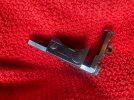RicinYakima
High Steppes of Eastern Washington
It is a long and complex story! From about 1921, when the Mark 1 rifles were finished, they were as good or better than anything commercially made. You must remember that Springfield was a "make work" project until about 1940. While Winchester and Pope made some match rifle barrels when the US was winning every rifle match in the world in the 1920's, most of the barrels were SA. The best were called "star gauge", or the biggest variance was 0.0005", 5 ten thousandths of an inch, the entire length of the barrel. Even their barrels for issue rifle, 90+% would make the star gauge factor. (I won three national matches with standard 1919-1937 barrels.)Okay. Good or bad? The bore is in very nice shape.
The Hatcher hole is a good idea. It should be exactly opposite to the gas relief hole. But remember, the action is casehardened both inside and out and you will need carbide tooling. If the case head fails, it will vent gas out the side rather than back along the bolt. (One of the reason for the knob on the back of the striker, to divert gas away from the soldier's face.)
Barrel quality did not go down until late 1942, when the US found out they could make enough M1 Garand's for all the first line infantry. '03's became the rifle for MP's, Engineers and Artillery until enough M1 carbines became available. Even then, the High Standard broached rifled barrels and Remington cut rifle barrels were of good quality. I have heard the SA would take not perfect M1 Garand barrel blanks and remake them into replacement barrels for USMC. Sedley took thousands of 2nd rate barrel blanks and made barrels for the USMC Springfields.
HTH, Ric

